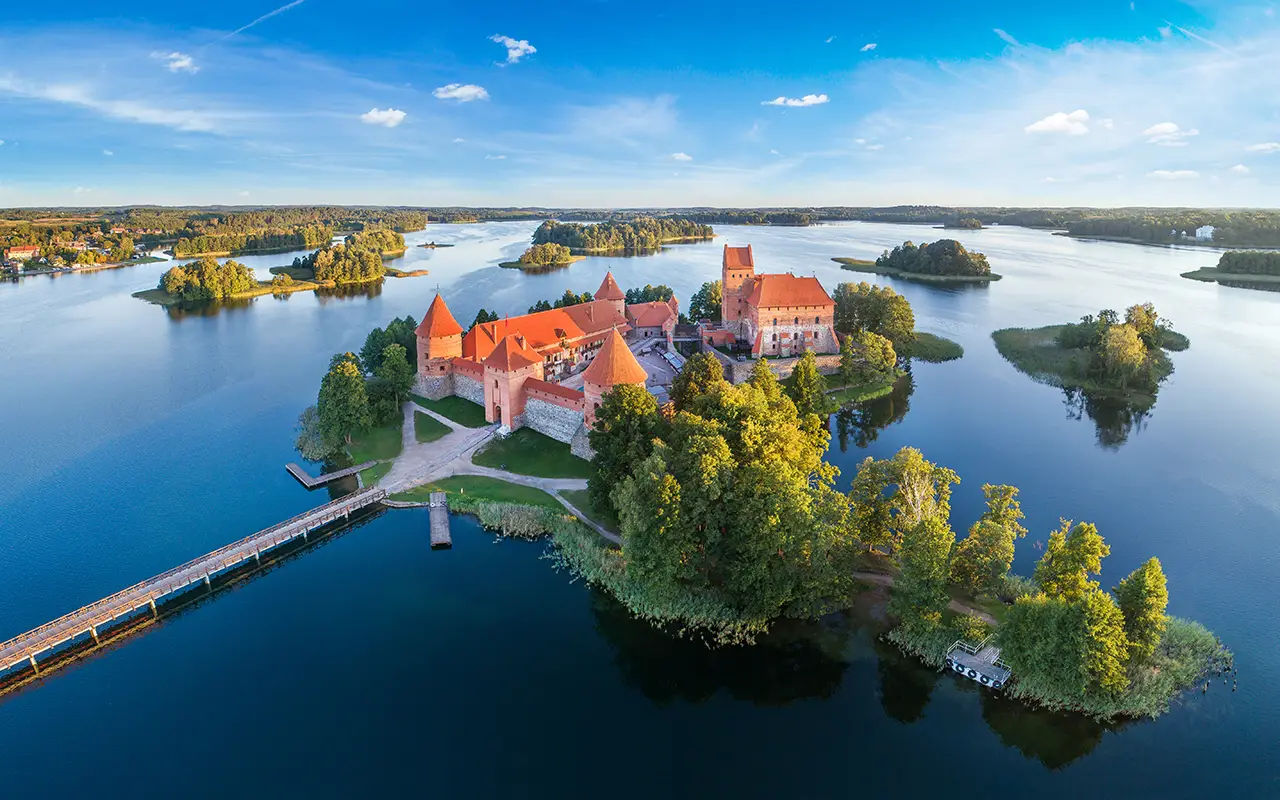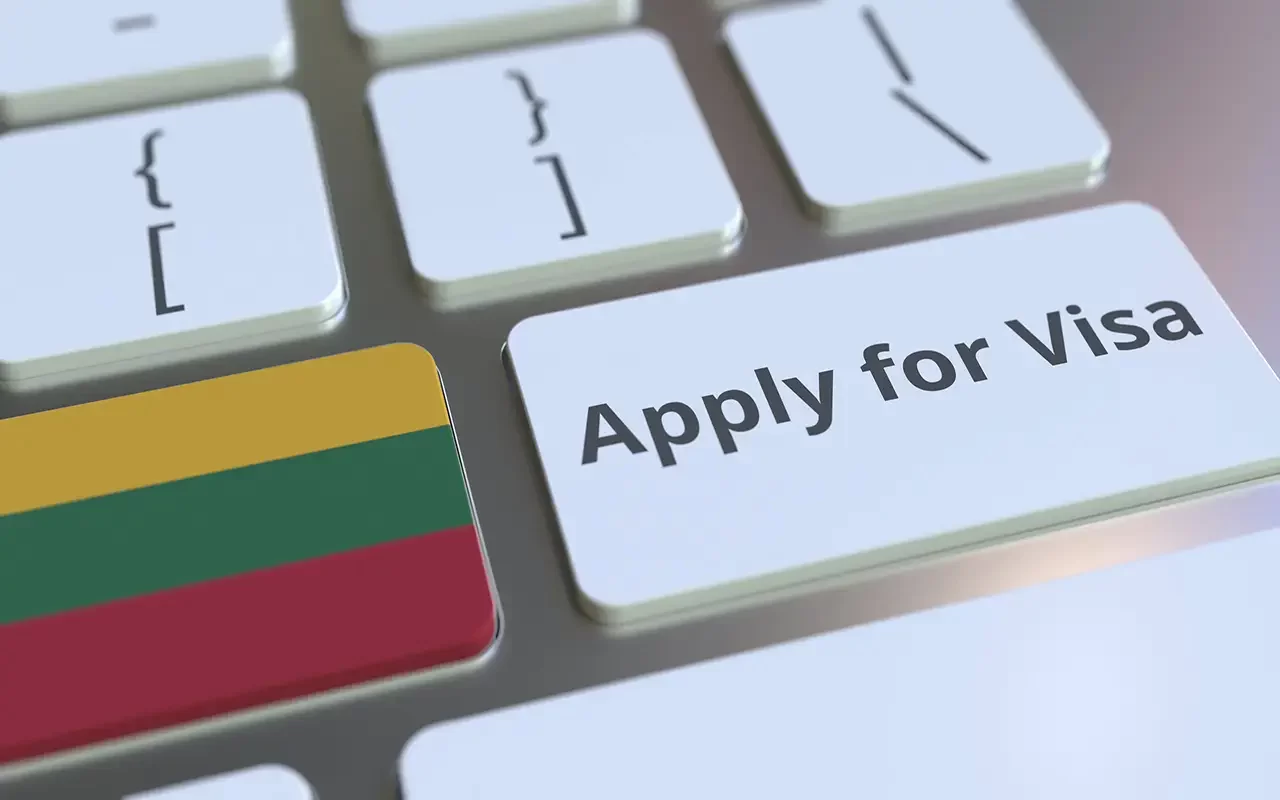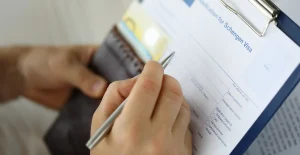
Table of Contents
Overview of Lithuania
Lithuania is a northern European country extending westward into the Baltic Sea. The southernmost Baltic state, it is located below Latvia, to the west of Russia and Belarus, and to the north of Poland. Its population of 2.7 million speaks Lithuanian. Historically part of the Russian Empire, Lithuania briefly became an independent state, but was subsequently absorbed into the Soviet Union post-WWII. After five decades behind the iron curtain, Lithuania became the first Baltic country to achieve its independence from the USSR, in 1990. The most ethnically and linguistically homogenous Baltic state, Lithuania today boasts a highly developed economy and high standards of living. Across Vilnius, its capital, Soviet-era buildings compete with Gothic, Renaissance, and Baroque architectural gems which define the city’s 13th-century center; a UNESCO Heritage Site. Perhaps the least overtly touristy of the Baltic capitals, Vilnius’ authenticity derives from its successful integration of its historic and modern elements. Visitors can stroll along Pilies street and visit Vilnius Cathedral (the city’s oldest street and church, respectively), and explore the capital’s living history in its Glass Quarter. Visit Uzipis, the city’s artistic Bohemian district, and learn about the German and Soviet occupation in its sobering yet informative museums. Explore Lithuanian cuisine through restaurants dedicated to using local ingredients and breathing new life into traditional dishes like Cepelinai, potato dumplings filled with cheese, paired with rye bread; a Lithuanian staple. Outside the capital, historic castles, churches and stately homes dominate the fields and forests of the countryside. An hour to the east of Vilnius is Kaunas, Lithuania’s second largest city, and cultural capital (Kaunas contains the country’s largest concentration of Art Deco buildings). Take a boat to the fairytale Trakai Castle, a 14th century island-wonder on the scenic Lake Galvė. Nature lovers can also visit Lithuania’s five National Parks, displaying the best of the country’s wildlife. Lithuania signed the Schengen Agreement in 2003, becoming part of the Schengen area in 2007.
Lithuania Schengen Visa Eligibility
Schengen visa eligibility for Lithuania includes third country nationals from the following states, who are excluded from visa-free to Lithuania/the Schengen area, and are therefore eligible to apply for a Schengen visa to Lithuania:
|
1. AFGHANISTAN |
53. LAOS |
|
2. ALGERIA |
54. LEBANON |
|
3. ANGOLA |
55. LESOTHO |
|
4. ARMENIA |
56. LIBERIA |
|
5. AZERBAIJAN |
57. LIBYA |
|
6. BAHRAIN |
58. MADAGASCAR |
|
7. BANGLADESH |
59. MALAWI |
|
8. BELARUS |
60. MALDIVES |
|
9. BELIZE |
61. MALI |
|
10. BENIN |
62. MAURITANIA |
|
11. BHUTAN |
63. MONGOLIA |
|
12. BOLIVIA |
64. MOROCCO |
|
13. BOTSWANA |
65. MOZAMBIQUE |
|
14. BURKINA FASO |
66. NAMIBIA |
|
15. BURMA/MYANMAR |
67. NAURU |
|
16. BURUNDI |
68. NEPAL |
|
17. CAMBODIA |
69. NIGER |
|
18. CAMEROON |
70. NIGERIA |
|
19. CAPE VERDE |
71. NORTH KOREA |
|
20. CENTRAL AFRICAN REPUBLIC |
72. OMAN |
|
21. CHAD |
73. PAKISTAN |
|
22. CHINA |
74. PAPUA NEW GUINEA |
|
23. COMOROS |
75. PHILIPPINES |
|
24. CONGO |
76. QATAR |
|
25. COTE D’IVOIRE |
77. RUSSIA |
|
26. CUBA |
78. RWANDA |
|
27. DEMOCRATIC REPUBLIC OF CONGO |
79. SAO TOME AND PRINCIPE |
|
28. DJIBOUTI |
80. SAUDI ARABIA |
|
29. DOMINICAN REPUBLIC |
81. SENEGAL |
|
30. ECUADOR |
82. SIERRA LEONE |
|
31. EGYPT |
83. SOMALIA |
|
32. EQUATORIAL GUINEA |
84. SOUTH AFRICA |
|
33. ERITREA |
85. SOUTH SUDAN |
|
34. ETHIOPIA |
86. SRI LANKA |
|
35. FIJI |
87. SUDAN |
|
36. GABON |
88. SURINAME |
|
37. GAMBIA |
89. SWAZILAND |
|
38. GHANA |
90. SYRIA |
|
39. GUINEA |
91. TAJIKISTAN |
|
40. GUINEA-BISSAU |
92. TANZANIA |
|
41. GUYANA |
93. THAILAND |
|
42. HAITI |
94. TOGO |
|
43. INDIA |
95. TUNISIA |
|
44. INDONESIA |
96. TURKEY |
|
45. IRAN |
97. TURKMENISTAN |
|
46. IRAQ |
98. UGANDA |
|
47. JAMAICA |
99. UZBEKISTAN |
|
48. JORDAN |
100.VIETNAM |
|
49. KAZAKHSTAN |
101.YEMEN |
|
50. KENYA |
102.ZAMBIA |
|
51. KUWAIT |
103.ZIMBABWE |
|
52. KYRGYZSTAN |
Third party nationals from the following entities/territories are also required to apply for a Schengen visa: KOSOVO and the PALESTINIAN AUTHORITY.
Required Documents for lithuania Visa
All documents required for your Lithuania Schengen visa must be written in Latin letters and should be completed/translated into Lithuanian or English. Applications for all Schengen visas to Lithuania will contain the following Basic Required Documents:
- Valid passport
- Passport sized photos
- Application form
- Fingerprints (biometric data)
- Travel medical insurance
- Visa Fee
- Materials related to your trip:
- Reason for visit
- Where you will stay (accommodation)
- How you will fund your trip (finances)
- Proof that you will leave Lithuania before your visa becomes invalid/expires. This is often in the form of a paid roundtrip plane ticket (proof of return).
Notes: In most cases, translations into either Lithuanian or English must be notarized by a licensed translator. For more information on what to include in your application, including a detailed description of required materials, please see: Basic Required Documents. Please note that you may have to submit additional Lithuanian Schengen visa supporting documents related to your specific purpose for travelling.
Lithuania Schengen Visa Fee
The standard Lithuania Schengen visa fee for an adult is 80 Euros. Certain types of applicants (most students, children under 6) are exempt from all visa fees. To get a Schengen visa for Lithuania, you will likely have to submit a service payment with your visa application-this is a separate cost from the visa fee. Please note that these fees are non-refundable in the case of visa rejection.

How to Apply for Lithuania Schengen Visa: Steps
- Step 1: Determine your Purpose for travelling to Lithuania, which will determine the Type of visa you should apply for.
- Step 2: Determine how many Entries to Lithuania/the Schengen area you need.
- Step 3: Gather your Required Documents.
- Step 4: Schedule a Schengen Visa appointment (if applicable).
- Depending on the location of the consulate/visa center you are applying through, you may have to schedule an appointment in order to submit your application. Alternatively, you may be able to drop off your application without prior arrangement, so long as you do so during normal operating hours. Contact your consulate/visa center directly to find out if you need to schedule an appointment in order to submit your application.
- Step 5: Fill out your application.
- In most cases, you should apply through Lithuania’s online visa application form, using Latin letters, though this link. Your application will be submitted to the consular services of the Republic of Lithuania. In addition to submitting the application electronically, you must also print out and submit a paper copy to whichever Lithuanian Consulate/visa center you are applying through.
- Step 6: Pay the application fee.
- Step 7: Submit your Lithuanian Schengen visa application (at least 15 days prior to travelling, not before 6 months).
- Different Lithuanian consulates/processing centers have different procedures for submitting applications. In almost all cases, applications must be submitted in person to the consulate/center you are applying through.
- When you submit your application, you will likely also be asked to submit biometric data (fingerprints). Children younger than 12 years are likely exempt from having their fingerprints collected. If you have previously submitted fingerprints (within the last 59 months), you likely will not need to resubmit them.
- Please note, after submitting your application, you may be asked to return at a later date for a personal interview to provide further information/materials related to your trip.
When to Apply
Submit your application at least 15 days prior to the day you intend to travel, and no earlier than 6 months before you leave.
Where to Apply
Applications for Schengen visas to Lithuania should be submitted at either a Lithuanian Consulate or a visa application center that has a relationship with Lithuania.
You should ideally lodge your application for a Lithuanian Schengen visa in the country where you legally reside/are a citizen.
In countries where there is no Lithuanian consular presence, applications may be lodged via the consulate of a Schengen state representing Lithuanian consular interests. If your country has neither a Lithuanian consulate/visa center nor a Schengen state representing Lithuania’s consular interests, you should apply through the nearest/most conveniently located Lithuanian embassy.
Processing Time for Lithuania Schengen Visa
The Lithuanian Schengen visa processing time is generally 15 days, although it can take up to 60 days in certain cases.
If your visa was approved:
Collect your visa and make sure the information it contains is valid and complete.
If your visa was denied:
If you receive a Schengen visa rejection for Lithuania you have the right to an appeal.
Begin this process by picking up your standard issued-visa refusal form, which describes why your request was denied, and explains the detailed steps of the appeal process.
Please note you may have to pay an appeal fee, which is likely non-refundable regardless of the outcome of the appeal (positive or negative).
Finally, once you obtain your Schengen Visa for Lithuania, please note the following:
Your visa may be revoked if you do not notify the Lithuanian Consulate/visa application center of any changes to your trip itinerary that occur after you have submitted your application.
Being approved for a Lithuanian visa does not guarantee you entry to either Lithuania or the general Schengen area – you can still be refused entry to both places upon arrival.
Alternatively, you may have to show additional documents regarding your finances or accommodation in order to enter Lithuania/the Schengen area.

